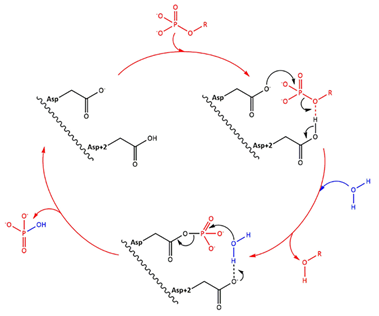Sandbox Reserved 1480
From Proteopedia
(Difference between revisions)
| Line 18: | Line 18: | ||
== Disease == | == Disease == | ||
| - | Different studies have shown that LHPP is a risk factor in | + | Different studies have shown that LHPP is a risk factor in major depressive disorder. Indeed, single nucleotide polymorphisms (SNPs) are linked with serotonin receptor 1A-1019C > G genotyp in two different populations. Enhanced expression of the HTR1A 1A-1019C > G autoreceptor is implicated in the reduction of serotonergic neurotransmission, which is considered to be one of the primary defects in depression, resulting in stress and vulnerability. |
| - | It has also been shown that LHPP is a histidine phosphatase and a tumour suppressor in hepatocellular carcinoma that removes histidine-linked phosphate groups from proteins. The absence of LHPP promotes the growth of tumors via increasing histidine-phosphorylated proteins. This study shown that LHPP was downregulated in hepatocellular carcinoma, but also two histidine | + | It has also been shown that LHPP is a histidine phosphatase and a tumour suppressor in hepatocellular carcinoma that removes histidine-linked phosphate groups from proteins. The absence of LHPP promotes the growth of tumors via increasing histidine-phosphorylated proteins. This study shown that LHPP was downregulated in hepatocellular carcinoma, but also that two histidine kinases (NME1 and NME2) were upregulated. Thus, the regulation of protein phosphorylation is important for the integrity of the cell and when deregulated could lead to tumorigenesis. Collectively, this study provides unprecedented hints on cellular functions of LHPP, and shows that LHPP inactivation together with high NME1/2 expression and - activity is a key tumorigenic event in hepatocellular carcinomas. |
| + | They also shown that LHPP act mainly on N3-phosphorylated proteins. | ||
The researchers led by Prof. Michael N. Hall from the Biozentrum, University of Basel, report in “Nature” that LHPP can also serve as a biomarker for the diagnosis and prognosis of liver cancer. | The researchers led by Prof. Michael N. Hall from the Biozentrum, University of Basel, report in “Nature” that LHPP can also serve as a biomarker for the diagnosis and prognosis of liver cancer. | ||
Revision as of 20:06, 7 January 2019
| This Sandbox is Reserved from 06/12/2018, through 30/06/2019 for use in the course "Structural Biology" taught by Bruno Kieffer at the University of Strasbourg, ESBS. This reservation includes Sandbox Reserved 1480 through Sandbox Reserved 1543. |
To get started:
More help: Help:Editing |
Structure of the protein LHPP
| |||||||||||
References
"Molecular cloning of a cDNA for the human phospholysine phosphohistidine inorganic pyrophosphate phosphatase." Yokoi F., Hiraishi H., Izuhara K. J. Biochem. 133:607-614(2003) [PubMed] [Europe PMC] [Abstract]
"The protein histidine phosphatase LHPP is a tumour suppressor." Sravanth K. Hindupur, Marco Colombi, Stephen R. Fuhs, Matthias S. Matter, Yakir Guri, Kevin Adam, Marion Cornu, Salvatore Piscuoglio, Charlotte K. Y. Ng, Charles Betz, Dritan Liko, Luca Quagliata, Suzette Moes, Paul Jenoe, Luigi M. Terracciano, Markus H. Heim, Tony Hunter & Michael N. Hall. (2018) [PubMed] [Main]

